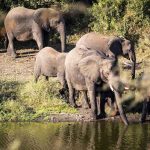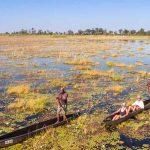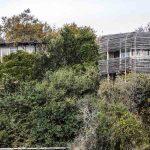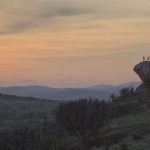Tarangire National Park has been described as Tanzania’s hidden gem.
We had the privilege of spending 3 amazing years managing Sanctuary Swala, an upmarket lodge in the southern regions of the park. Tarangire is one of four parks that make up Tanzania’s Northern circuit, but because of its location just off the main Northern Route, time spent in Tarangire is often kept to a minimum of 24 hours. Unfortunately the park is also excluded from some safari itineraries in favour of spending more time in the famous Serengeti National Park or Ngorongoro Crater. As a result of this, the park tends to attract less visitors than most National Parks in the Northern Tanzania and this only serves to enhance the attractiveness of spending time in Tarangire.
Tarangire National Park covers an area of 2850 km², making it the sixth largest National Park in Tanzania. The Tarangire River, from where the park gets its name, meanders through the National Park providing a life source for the large volumes of wildlife that frequent the area, particularly in the dry season. Tarangire is known for the large volumes of game that call this park home, particularly from July through to November.
Productive Water-holes
During these months Tarangire can boast of having some of the highest wildlife concentrations in Tanzania and the highest concentrations of elephants in the world! During our time in Swala Camp we spent our time surrounded by elephants, with up to 50 bull elephants visiting our waterhole on a daily basis during the dry season. The bulls push and shove, squealing with frustration as they fight over the meagre supply of water, much to the delight of guests ensconced on decks overlooking the panoramic view.
The days were also filled with the sounds of hundreds of zebras barking, as they squabbled for position the thirst-quenching water hole. Impalas spread themselves throughout the camp, watching guests and staff with curious eyes, but to the presence of humans in their world.
Tarangire is home to large herds of buffalo and share space with the usual contingent of wildebeest, zebras, elands, Thompson’s gazelles and giraffes that one would expect to see while on safari in Tanzania. In addition there are Coke’s hartebeest, bohor reedbuck, fringe-eared oryx, lesser kudu, gerenuk and clans of dwarf mongoose are some of the rarer species that call Tarangire home.
Tarangire is also home to large numbers of predators such as lion, leopard, cheetah and wild dogs. We were lucky have a large number of predators in the area where we lived. Lions were regular visitors into camp and in the dry season, when water was in short supply, guests were thrilled to have their dinner interrupted with the arrival of a pride of lions or a leopard to the swimming pool for drink after dark! On most nights we were serenaded to sleep by the roars of the resident lion prides communicating. Some nights the roars of competition resounded from within the camp, as the territorial males voiced their warnings to other males to stay away!
Swamps and Forests
In November, the arrival of the short rains bring with them a change in the concentrations of the animals in the park. The Tarangire ‘mini migration’ begins with the plains game departing to feed on the new ‘sour veld’ grasses offered in the Rift Valley and on the Maasai Steppe. Although the plains game numbers are reduced at this time, Tarangire still has lots to offer, with the rain delivering some of the best birding opportunities in Tanzania.
The terrain in Tarangire is very diverse, with vast areas of grasslands and rolling hills bisected by the Tarangire River. Tall palm trees flank the banks of the river as you travel south into the park and there are large stands of Acacia woodland throughout the park. As one travels South in the park the terrain changes again as the rolling grasslands give way to a number of shallow swamps that Tarangire is famous for.
These swamps are not swamps in the true sense of the word, but are a series of shallow seasonal lakes or vleis that are a valuable source of water throughout the dry season. It is to these swamps where the intra-African and Palearctic migrants flock in November, as the short rains flood the swampy terrain. In the Silale swamp south of Boundary Hill, we were fortunate to witness approximately 250, 000 birds, comprising over 100 different species, availing of the bounty that the flooded swamp provided.
Tarangire is also well known for the amount of majestic baobab trees in the park – there are literally forests of these gigantic trees! We will never forget our first drive into Tarangire. We had just arrived from South Africa and had been told that Tarangire would be the place for us if we liked lots of elephants and baobabs – the two African giants! But nothing prepared us for what we encountered when we entered Tarangire.
As we progressed into the park, the scenery took our breath away, we felt as if we had walked into a scene from Out of Africa. As our game viewer mounted the crest of a hill, the scene that unfolded was one of rolling hills of grass land where elephants were dotted like cattle, all sorts of wild life roamed and grazed between the iconic stands of umbrella thorn (Acacia tortilis) and took refuge from the African sun under the huge canopy of the hundreds of baobab trees that helped to form this beautiful countryside.






